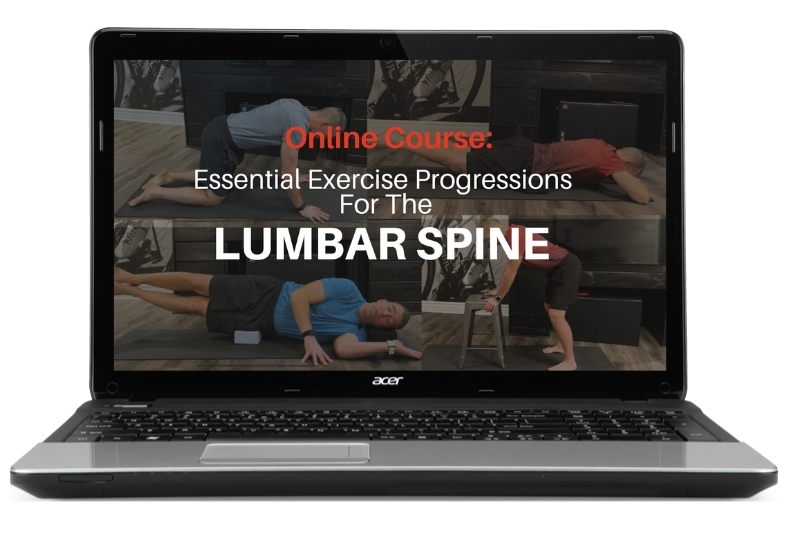Be more confident, efficient, and effective with lower back pain treatment and rehabiitation
Essential Exercise Progressions For The Lumbar Spine [Online Course]

$199.00
What’s Included:
- Exercise progressions for pain, mobility, motor control, strength, and optimal spine health
- 8 hours of content
- Learn at your own pace 24/7
- 6 months access with registration
- Certificate of completion included with course
*prices are in USD*
"A must-take course for any clinician or therapist treating lower back pain patients."
Course Outline:
Part 1: Rethinking Exercise Prescription
Most people think about exercise prescription in terms of what exercises to prescribe for a certain condition. But this assumes each of these conditions is exactly the same. But they’re not.
There’s no such thing as an exercise for sciatica, facet syndrome, or plantar fasciitis, or ITB syndrome.
Instead, we must understand that certain exercises will have different mechanical, physiological, and neurological effects.
These effects may relate to the neurological inhibition of pain, to tissue healing, motor control and coordination, or improved flexibility, muscle strength, or enhanced connective tissue health and organization.
So effective exercise prescription requires us to understand these effects, and to prescribe and program these exercise effects to meet the unique needs of the specific patient in front of us.
That’s what this course is all about.
Part 2: The Movement Hierarchy
Once we understand the effects of different types of exercises we need to know how to apply these to each patient.
Here we’ll introduce the “Movement Hierarchy”.
This is a systematic framework to help us understand the 4 key attributes we must develop for each specific joint in the lumbar spine (tolerance – motor control – flexibility – strength), as well as the also the order in which we need to develop them.
Part 3: Understanding Modern Pain Science
Pain is the primary complaint of most of our patients. So we need a basic knowledge of what pain is and why it occurs.
But modern pain science has drastically changed our understanding of pain. We now know that pain is not so much a result of tissue damage or faulty movement patterns. Instead, modern science tells us pain is output generated by the brain meant to protect us.
In this section we’ll provide a summary of the modern understanding of pain. Here we review the evolutionary origins of the pain system, why our pain system will often become hyper-sensitive (smoke detector principle), and the role of learning and past experiences (sometimes the body can learn to hurt). This of course has far reaching effects for clinicians and therapists.
Part 4: The Effects Of Exercises On The Brain: Smudging & Cortical Reorganization
We don’t just have a physical body. We also have a map of the body residing within the brain. A neurological representation of each of our muscles and joints. But modern science now tells us that these maps are not simply genetically predetermined and static. Instead, they are continually changing based on how we are using (or not using) our bodies.
Why does this matter?
Because in many cases, these neuroplastic changes can be associated with recurrent and chronic pain.
Phantom limb pain is one extreme example, but studies also demonstrate neurological smudging and cortical reorganization with common conditions such as lower back, knee, and elbow pain. This phenomena of cortical reorganization also accounts for many of the seemingly strange symptoms that occur with lower back pain, including migrating symptoms that come and go and seem to move around to different body area.
But the fact that these body maps are always changing also means we can influence these maps with our exercise prescriptions. But not all exercises will do this. As discussed in this section, there are certain requirements that must be met for exercises to change the brain.
Part 5: Putting It All Together: A Systematic Model Of Care
Now it’s time to translate theory and science into practice. We’ll review a simple treatment model that we can use to understand not only the effects of different types of exercises, but also how to prescribe and program these various exercises to patients with lower back pain.
Here we’ll talk about the order-of-operations, and how to prioritize your treatment goals. This will include how to most effectively progress your patients through the various stages of care and exercise programming — from acute pain, to spine mobility and control, to lumbar strength and endurance.
Part 6: Introduction To The Lumbar Spine
Now it’s time to get into the specific exercises themselves. But here it is critical to understand that we don’t have a lumbar spine in the same way that we have a hip, or knee, or ankle. These are single joint systems which means they are easier to target and direct an exercise stimulus/effect at the specific joint or affected tissue.
But the spine consists of a series of joints that form a mobile column. And for our exercises to be most effective, we need a way to target the specific individual spinal joints (and adjacent discs, ligaments, and muscles).
We can’t just prescribe a general exercise to the lower back and expect this to change or affect a specific joint or spinal segment. Yet this is what most traditional lower back exercises do. (Think of a cat/camel, knee-to-chest, or prone extension/cobra stretch. None of these stretches are able to direct a stimulus to a specific joint level.
A similar limitation occurs with “core” exercises like planks, bridges, or bird dogs.)
So in this section we’ll review better movement options that we can use to more specifically target the individual joints and local muscles of the lumbar spine. These are the movements that will form the foundation of our lumbar spine exercises.
Part 7: Exercises For Acute Low Back Pain And The Movement Sensitive Spine
This section includes the exercises we’ll prescribe for both acute and chronic lower back pain patients thast we classify as being “movement sensitive”. These are patients in which basic motion of the lumbar spine causes pain. When this is the case this must be the starting point with our exercise programming.
Here we’ll review the exercises themselves, as well as key programming considerations (how many sets, reps, and optimal exercise frequency). We’ll also discuss progression and regression criteria, as well as what’s Ok and not OK as far as any symptoms that may occur with the exercises.
Finally, we’ll talk about how to best communicate this with patients to develop trust and confidence with the exercises themselves, and with you as their clinician or therapist.
Part 8: Exercises For Lumbar Mobility & Motor Control
In this section we’ll review the Basic Lumbar Movement Sequence/Routine we’ll prescribe to build mobility and control of the lumbar spine. This is a critical section as it not only serves as a key progression from our pain/tolerance based exercises, but it also helps drive our overall treatment process.
This Basic Movement Sequence/Routine consists of exercises that encompass all of the key movements that a healthy and functional spine must be capable of. This means getting the lower back more capable of performing these exercises properly is a critical goal of care.
It’s also why this sequence should be a critical component of long-term spine health and maintenance for all lower back pain patients.
Part 9: Exercises For Lumbar Spine Strength & Endurance
The section reviews the exercises we’ll use to develop strength and endurance of the lumbar spine. But unlike traditional exercises like planks, side-bridges, bird-dogs, or bridges, these exercises don’t just train the spine isometrically. Instead, the goal here is to develop strength and control of the lumbar joints through a full ROM.
This section further breaks these exercises down based on the specific joint motion/direction (flexion, extension, and lateral flexion). For each joint motion we’ll review and demonstrate exercises suitable for beginners who need to start with basic lower-intensity exercises, all the way through high-level exercises for patients and clients with training experience and more physical occupational or sport demands.
Part 9: Bonus Section: Hip Mobility Considerations For Lower Back Pain
While not technically part of the lumbar spine, it is common for the hips to be tight and limited with lower back pain. This is particulary true for the hip flexor and hamsting groups.
In this bonus section we’ll review key stretches to targert these key groups.
Here we’ll have a strong focus on proper form with the exercises. This is critical as traditional hip stretches can not only be less effective but will often flare-up a painful or sensitve lower back when done with poor or incorrect form.

Presenter Bio: Dr Jason Gray BHK DC MSC
Dr. Jason Gray is an honors graduate (Cum Laude) of Logan College of Chiropractic in St. Louis, Missouri (2004), and holds a Master of Science degree in Kinesiology from Dalhousie University (2011), with a focus on running biomechanics and clinical assessment.
In addition to his chiropractic training, Dr. Gray has advanced training in musculoskeletal rehabilitation, strength training and conditioning, and biomechanics. He has been has been a full-body certified A.R.T. provider since 2004, and is a certified provider of Functional Range Release (FRR), Functional Range Assessment (FRA), and is a certified Functional Range Conditioning Mobility Specialist (FRCms).
Dr. Gray has published multiple articles in chiropractic trade journals and has written about and taught sport performance & injury prevention programs for a number of sports, including Crossfit, golf, running, swimming, and triathlon.
He founded My Rehab Connection in 2016.
Frequently Asked Questions:
How long do I have access to the course?
After signing-up you will have full access to the course for 6 months.
Who is this course for?
If you are a clinician or therapist (Chiropractor, Physiotherapist, Massage Therapist) and work with lower back pain patients, then this couse is for you!
Can I get CE credit for this course.
There is a Certificate Of Completion to confirm you have compelted 8 hours of online CE provided by Dr. Jason Gray.
Please check with you governing assocaition to detemine if this is eligible for your specific CE requirements.
Do I need to subscribe to your exercise software to take the course.
No. This course is meant to be a stand-along course.
If you do use our software all of the exerices reviewed in the course are available in the software.
